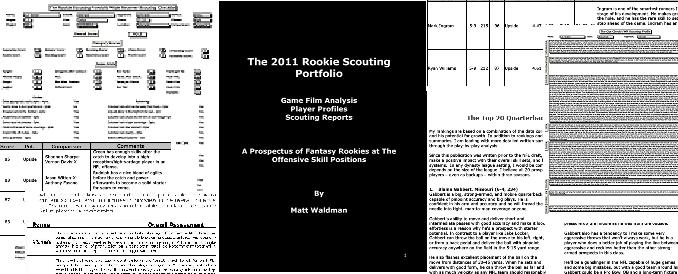
Quick Take: Lache Seastrunk
One of my favorite runners in the NFL is Ahmad Bradshaw. He was never going to be a dominant player, but there’s no denying his combination of skill and heart. One of my favorite games I’ve ever watched of a running back was Bradshaw at Marshall versus an excellent Tennessee run defense. Bradshaw had to work incredibly hard to just reach the line of scrimmage on most runs and it was a telling performance of his NFL future.
Bradshaw’s footwork, pad level, quickness, and balance have been hallmarks of his game. If he didn’t have a chronic foot injury, his career would have been even better than what we saw in New York. This sounds a bit like a career epitaph for the back whom the Giants released this week. Who knows. Whether or not he continues to thrive, he earned the respect of anyone who truly watches football.
[youtube=http://youtu.be/bCL87fQxXK8]
A player who reminds me of Bradshaw after a first look is Baylor sophomore Lache Seastrunk. Quick feet, excellent burst, the skill to layer cuts and set up defenders in tight spaces, and moments of excellent pad level and fight after contact. Most of my readers probably know about him. If you’re a casual college fan, here’s an introduction.
Thank You
First, thank you all for the birthday wishes on Wednesday. It’s incredibly humble to get the kind of outpouring I received on Twitter. If you’re a new follower as a result, I’d like to thank you for checking out what I do. Each Friday at the RSP blog, I post a variety of things to read, listen, and view about football and anything else that I find insightful, funny, or entertaining.
It’s also the time I like to thank my readers who purchase the Rookie Scouting Portfolio publication. Available for download every April 1 (no joke) for going on eight years, the RSP is an online .PDF publication devoted to the play-by-play study of NFL prospects at the offensive skill positions. The publication has a menu that bookmarks the document so you have two types of analysis. The first portion is a magazine-style, pre-draft analysis of 120-150 pages that includes position rankings, player comparisons, skill set analysis of each position, and sleepers.
The second portion is where I show all my work: between 700-800 pages of grading reports, play-by-play analysis of every player and game I watched, and a glossary that defines every criteria in my grading reports. My readers who want the bottom line love the first half of the book and appreciate the transparency of this section. My hardcore readers love the fact that they can dive as deep as they want into these raw play-by-play notes.
Included with the RSP (since 2012) is a post-draft document between 50-70 pages that comes out a week after the NFL Draft with updated post-draft rankings, tiers, team fit analysis, and fantasy cheat sheet with value analysis (Russell Wilson was calculated as the best value last year). Fantasy owners can’t get enough of it.
The RSP is $19.95 and I donate 10 percent of each sale to Darkness to Light, a non-profit dedicated to training individuals and communities on the prevention of sexual abuse. Past years of publications (2006-2012) are available for $9.95 and I also donate 10 percent of each sale to D2L. You can prepay for the 2013 RSP now.
Listens
Robert Henson, the bassist I used to play with in high school, is now a professional musician who tours with Corey Smith, has a group called Telegram, and performs around the southeast with every kind of idiom imaginable, ranging from pit orchestras to folk to jazz. Here’s Madonna’s “Like a Virgin” with a heavy dose of Texas BBQ at the Velvet Note, new venue in Atlanta with world class acoustics. Funny and well done.
[youtube=http://youtu.be/hUVQR4Yww1o]
Views
Rightfully so, we’re in awe of Adrian Peterson’s second-half run of production while recovering from an ACL injury and a sports hernia. However, I think perhaps we ought to turn to our spouses and feel that same sense of awe when we think of them giving birth to our children. Here are two guys from Holland opting to experience what contractions feel like. Funny and partially insightful. I say partially because my friend Sarah who posted this video on her Facebook page titled, “Labor. It’s not for the feint of heart,” followed up with this comment:
“The really funny thing is that they STILL have no idea what it’s like because
- They knew they could bow out at any time and didn’t have to see it to completion and
- They missed the whole push-a-living-being-out-your-vagina part.
BUT, a valiant endeavor, nonetheless.”
[youtube=http://youtu.be/A44oEcmDn1c]
Perhaps football’s Wolverine will give this a try for a charitable cause – once he recovers from that hernia.
Football Reads
- The Sideline View: Four Players from 2012 Who Could Change Things
- Laurent Robinson worried about his future after concussions
- Danny Kelly’s breakdown of the 49ers run game The Super Bowl may be over, but if you’re not reading Kelly’s work, you’re missing great football analysis.
Non-Football Reads
- Wayne Shorter: How Do You Rehearse the Unknown? This is the transcript, but you can also listen to the interview.
- What’s Next for CNET After The Dish Debacle? The implications of business ties eroding journalism.
- Gun Violence in America: The 13 Questions (With 13 Concise Answers)
































